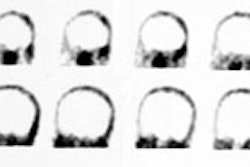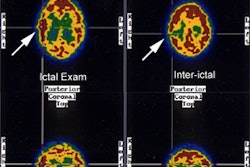J Nucl Med 2001 Jun;42(6):853-8
Ictal hyperperfusion of cerebellum and basal ganglia in temporal lobe
epilepsy: spect subtraction with mri coregistration.
Shin WC, Hong SB, Tae WS, Seo DW, Kim SE.
The ictal hyperperfusion (compared with the interictal state) of the cerebellum
and basal ganglia has not been investigated systematically in patients with
temporal lobe epilepsy (TLE). Their ictal perfusion patterns were analyzed in
relation to temporal and frontal hyperperfusion during TLE seizures using SPECT
subtraction. METHODS: Thirty-three TLE patients had interictal and ictal SPECT,
video-electroencephalographic (EEG) monitoring, and volumetric MRI. SPECT
subtraction with MRI coregistration was performed using commercial software. The
presence of ictal hyperperfusion was determined in the ipsilateral and
contralateral temporal lobe, frontal lobe, cerebellum, and basal ganglia.
RESULTS: All patients showed ictal hyperperfusion in the temporal lobe of
seizure origin. Vermian cerebellar hyperperfusion (CH) was observed in 26
patients (78.8%) and hemispheric CH was found in 25 (75.8%). Compared with the
side of the epileptogenic temporal lobe, there were 7 patients with ipsilateral
hemispheric CH (28.0%), 15 with contralateral hemispheric CH (60.0%), and 3 with
bilateral hemispheric CH (12.0%). CH was observed more frequently in patients
with additional frontal hyperperfusion (14/15, 93.3%; 2 ipsilateral to the
seizure focus, 10 contralateral, and 2 bilateral) than in patients without
frontal hyperperfusion (11/18, 61.1%). Among 18 patients with temporal
hyperperfusion without frontal hyperperfusion, 11 patients showed hemispheric CH
(5 ipsilateral to seizure focus, 5 contralateral, 1 bilateral). Hyperperfusion
in the basal ganglia (BGH) was seen in 11 of the 15 patients with temporal and
frontal hyperperfusion (73.3%) and in 11 of the 18 with only temporal
hyperperfusion (61.1%). In 17 patients with unilateral BGH (13 ipsilateral to
the seizure focus, 4 contralateral), CH contralateral to the BGH was observed in
14 (82.5%), CH ipsilateral to the BGH was found in 2 (11.8%), and CH bilateral
to the BGH was found in 1 (5.9%). CONCLUSION: During TLE seizures, hemispheric
CH occurred not only in contralateral but also in ipsilateral or bilateral
cerebellar hemispheres to the side of seizure origin. Although temporal lobe
origin seizures associated with additional frontal hyperperfusion produced more
frequent hemispheric CH, seizures showing only temporal hyperperfusion without
frontal hyperperfusion could produce BGH and CH. To determine the side of
hemispheric CH, the most important factor appears to be the side of BGH, not the
side of seizure origin.



